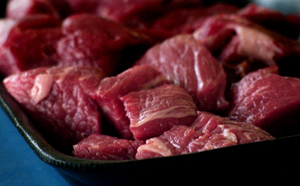Unclear if local stores are stocking gassed meat
Consumers do not want to buy discolored meat.
To preserve the red color of beef, the FDA allows the use of
carbon monoxide in meatpacking. Critics of the practice say that
carbon monoxide can preserve the color of red meat after it has
spoiled.
Unclear if local stores are stocking gassed meat
Consumers do not want to buy discolored meat.
To preserve the red color of beef, the FDA allows the use of carbon monoxide in meatpacking. Critics of the practice say that carbon monoxide can preserve the color of red meat after it has spoiled.
The colorless, tasteless gas is toxic to humans, but treating food with it leaves no residue. What it may leave in its place is the notion that perishable meat is fresh long after it’s begun to degrade.
“The use of carbon monoxide in meat packaging is clearly deceptive to consumers,” said Donna Rosenbaum, Executive Director of Safe Tables Our Priority, a consumer group. “Consumers rely on color to make meat purchasing decisions.”
Safeway does not sell meat that was packed with carbon monoxide, according to a press release from consumer groups.
A spokesperson for Nob Hill, Amy Johnson, said that Nob Hill declines to comment.
On Oct. 30, the House Committee on Agriculture held a public hearing to review technologies in the meat industry, according to the Committee Web site. All three of the speakers from the private sector who gave testimony about carbon monoxide supported its use in meatpacking.
The committee heard testimony from Phil Minerich, vice president of research and development for Hormel Foods and Scott Eilert, vice president of research and development for Cargill Meat Solutions.
Cargill is the second largest beef processor in the United States, according to their Web site. They sell fresh meat to virtually every major distributor, wholesaler, and chain.
Rick Roop, vice president of science and regulatory affairs for Tyson Foods, Inc. also testified.
Tyson no longer uses carbon monoxide due to complaints from consumers, according to the press release.
Consumer groups that are against the use of carbon monoxide in meatpacking were not invited to attend.
“To not have that perspective on the panel I think does a disservice to the debate,” said Chris Waldrop, director of the Food Policy Institute at the Consumer Federation of America, a consumer group.
In testimony before the committee, Alfred Almanza, administrator of the Food Safety and Inspection Service, and Joseph Sebranek, a professor at Iowa State University, both said that the use-by and freeze-by dates for meat protect consumers from purchasing spoiled beef that looks fresh.
Consumer Reports found that beef can spoil before its use-by or freeze-by dates and retain its red color, according to a July 2006 article by Consumer Reports.
The article recommended that consumers buy meat several weeks before its use-by or freeze-by date, or ask if their grocery store sells meat that is packed with carbon monoxide.
On Nov. 13 the House Subcommittee on Oversight and Investigation is planning another hearing regarding carbon monoxide.
“They are going to extend an invitation to some of us who were excluded from last week’s committee,” said Corbo, from Food and Water Watch, a consumer group.










